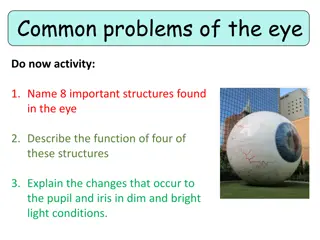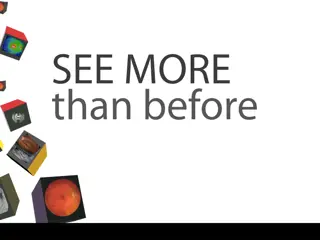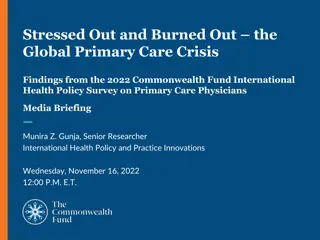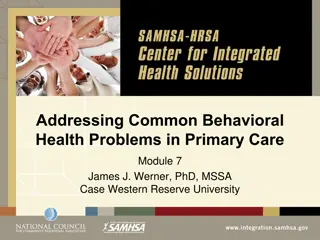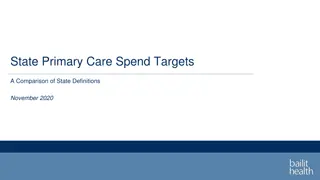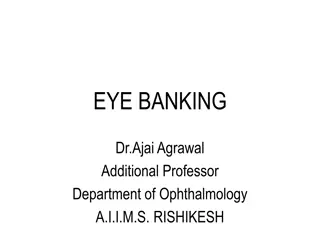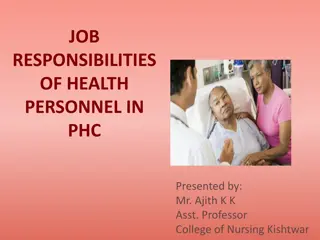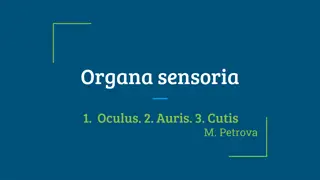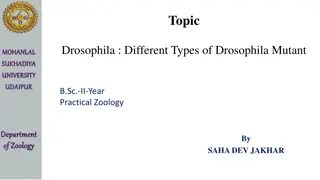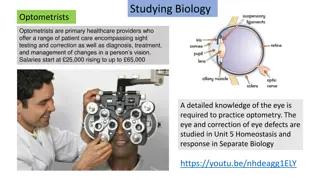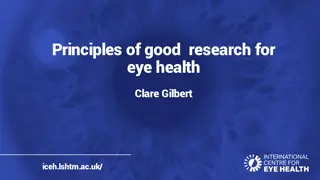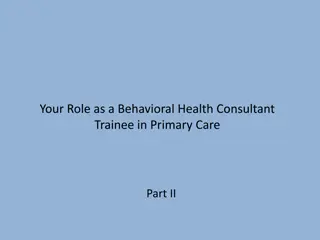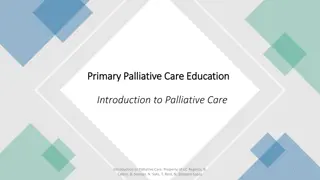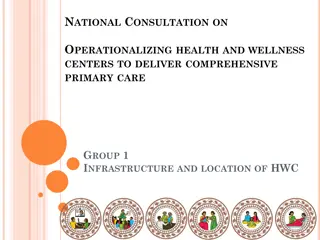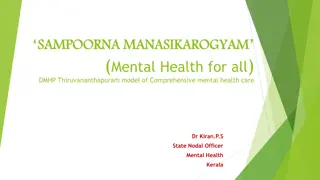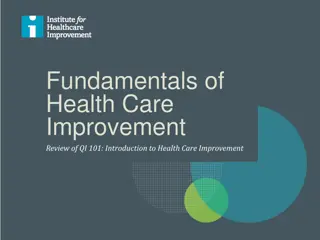The Importance of Primary Eye Health Care: Challenges and Solutions
Primary eye health care is crucial due to the high number of people worldwide suffering from vision impairments, with a significant portion being avoidable. This webinar by Clare Gilbert sheds light on the need for improved eye health services, covering various eye conditions and the interventions required. Explore the different groups of conditions, estimates of impact in different regions, and the definition of primary eye health care according to WHO. Understanding primary eye health care is key to addressing the global burden of vision impairments effectively.
Download Presentation

Please find below an Image/Link to download the presentation.
The content on the website is provided AS IS for your information and personal use only. It may not be sold, licensed, or shared on other websites without obtaining consent from the author. Download presentation by click this link. If you encounter any issues during the download, it is possible that the publisher has removed the file from their server.
E N D
Presentation Transcript
Why is primary eye health care needed? Primary Eye Health Care Webinar June 13 2022 Clare Gilbert iceh.lshtm.ac.uk/
The need 596 million distance vision impairment 43 million of whom are blind 510 million near vision impairment Total: 1.1 billion one in 7 of the world s population 90% live in low- and middle-income countries 90% is avoidable But, this does not include people at risk of vision impairment ...or those who have mild conditions with troublesome symptoms
Types of eye conditions Strategy Examples Interventions needed Group Treatment will improve or restore vision Uncorrected refractive errors, cataract, presbyopia Cataract surgery, optical correction Group 1 End stage glaucoma and retinopathy of prematurity, congenital anomalies, dense corneal scarring etc Treatment cannot restore vision Group 2 Vision rehabilitation Early detection and management with life- long care At risk of VI if not detected and treated Early glaucoma, diabetic retinopathy, age related macular degeneration (wet form)* Group 3 Not at risk of VI but symptoms need treatment Treatment as appropriate, often topical Group 4 Conjunctivitis, dry eye, lid infections
Estimate of numbers per 100,000 population Latin America 9,500 Asia 19,000 Africa 13,500 Group 1 conditions Cataract Uncorrected refractive error (distance) Uncorrected presbyopia Group 2 conditions Blind/VI from glaucoma, AMD, DR, others Group 3 conditions Undetected glaucoma At risk of diabetic retinopathy Group 4 conditions Non-visually impairing eye condition (5% of pop) 1,000 2,500 6,000 1,500 2,500 15,000 500 1000 12,000 1,200 1,200 1,000 1,500 800 700 750 450 800 700 500 200 5,000 16,900 (17%) 5,000 26,500 (27%) 5,000 20,000 (20%) Total (%) affected in a population of 100,000 See online version for how estimates were derived
What is primary eye health care? Primary Eye Health Care Webinar June 13 2022 Clare Gilbert iceh.lshtm.ac.uk/
Terminology (from WHO) Primary care (PC) Clinical services delivered in the community by front-line health workers Primary health care (PHC) Clinical services + health promotion (broad policies + empowering people/communities) Eye care fitted into these concepts Primary eye care (PEC) Eye care services delivered in the community by front-line health workers Primary eye health care (PHC) Eye care services + eye health promotion (broad policies + empowering people/communities)
Relationship between Primary Health Care and Primary Eye Health Care PRIMARY HEALTH CARE INTEGRATED PRIMARY CARE AND PUBLIC HEALTH SERVICES MULTISECTORAL POLICIES AND ACTION EMPOWERED PEOPLE AND COMMUNITIES
Relationship between Primary Health Care and Primary Eye Health Care PRIMARY HEALTH CARE INTEGRATED PRIMARY CARE AND PUBLIC HEALTH SERVICES MULTISECTORAL POLICIES AND ACTION EMPOWERED PEOPLE AND COMMUNITIES HEALTH PROMOTION
Relationship between Primary Health Care and Primary Eye Health Care PRIMARY HEALTH CARE INTEGRATED PRIMARY CARE AND PUBLIC HEALTH SERVICES MULTISECTORAL POLICIES AND ACTION EMPOWERED PEOPLE AND COMMUNITIES Preventing eye conditions; detecting and managing simple eye conditions; detecting and referring complex eye conditons PRIMARY EYE CARE HEALTH PROMOTION
Relationship between Primary Health Care and Primary Eye Health Care PRIMARY HEALTH CARE INTEGRATED PRIMARY CARE AND PUBLIC HEALTH SERVICES MULTISECTORAL POLICIES AND ACTION EMPOWERED PEOPLE AND COMMUNITIES Preventing eye conditions; detecting and managing simple eye conditions; detecting and referring complex eye conditons Policies and action which reduce eye conditions and increase access to eyecare services People know how to prevent eye conditions and are able to seek eye care services when needed PRIMARY EYE HEALTH CARE EYEHEALTH PROMOTION
Relationship between Primary Health Care and Primary Eye Health Care HEALTH PROMOTION PRIMARY HEALTH CARE INTEGRATED PRIMARY CARE AND PUBLIC HEALTH SERVICES MULTISECTORAL POLICIES AND ACTION EMPOWERED PEOPLE AND COMMUNITIES Preventing eye conditions; detecting and managing simple eye conditions; detecting and referring complex eye conditons Policies and action which reduce eye conditions and increase access to eyecare services People know how to prevent eye conditions and are able to seek eye care services when needed PRIMARY EYE HEALTH CARE HEALTH PROMOTION SECONDARY LEVEL EYE CARE








